This CE Center article is no longer eligible for receiving credits.
What type of housing is most needed in the United States? As the push toward urbanization in the country continues a decades-long trend, multifamily developments are perhaps the most necessary. According to the U.S. Census Bureau, urban areas now account for 80.7 percent of the U.S. population, and the growth rate for these areas is 12.1 percent, compared to a 9.7 percent growth rate for the country as a whole.1 The movement is likely to continue as members of the millennial generation (born between the 1980s and mid- to late 1990s) leave small towns and move to urban areas. A National Public Radio story titled “Millennials Continue Urbanization of America, Leaving Small Towns” emphasizes that the millennial generation prefers the opportunities, excitement, and walkability of urban areas.2 Density itself is also a draw. In fact, to slow down the small-town population drain, the Federal Reserve suggests increasing the density in small towns to make them more desirable to younger generations.3 The Federal Reserve is a central bank system that includes the Board of Governors in Washington, D.C., and 12 independent regional Reserve banks. They call their strategy “a small-town approach to new urbanism.”

All images courtesy of TAMLYN
This multifamily housing development that is durable and aesthetically appealing relies on superior moisture management for the building envelope, as well as innovative extruded aluminum trim and reveal pieces.
As a consequence of urban growth and the need for housing density, the design and construction of multifamily housing units are more important than ever. The new units developed in growing urban and even suburban and small-town areas must be both high performing and high style. Innovations in building materials make both increased function and form possible, from highly engineered drainage planes to durable and stylish exterior trim and reveal pieces that bring a chic modernism to multifamily projects.
But before discussing form, let’s start with the basic necessity for superior function: keeping the building envelope drained and dry.
Trapped Moisture Is the Enemy of Building Envelopes
As most building professionals know, water is the most significant factor in the premature deterioration of buildings, and proper steps should always be taken to protect the envelope.
One hundred years ago, “leaky” buildings with few strategies to prevent air and water intrusion were perfectly adequate. Exterior materials were applied shingle style to shed rainwater and block wind, and that was that. While these buildings might not have provided the consistent comfort we have come to expect, the buildings were able to become wet and then dry out, get wet and dry out, in continuous cycles. Wood materials, for example, expanded and contracted with the weather, and little harm was done.
Then came air-conditioning, the oil embargo in the 1970s, and increasing awareness that the burning of fossil fuels was harming our environment. It became clear that the energy used for the comfort of air-conditioning and heating would need to be lessened by the tightening up of buildings. The architecture, construction, and manufacturing industries became leaders in this movement.
This quest to make homes more energy efficient brought about a new set of challenges. The moisture that once entered the envelopes of buildings and then dried out quickly and naturally was no longer doing so. That process was impeded by the introduction of sheathing, housewraps, increased insulation, non-vapor-permeable interior wall coverings, and other modern materials and methods. Moisture problems multiplied. But the problems were not solved immediately.
A combination of temperate climates and minimal building codes contributed to the delayed resolution of moisture problems. But as extreme weather has become more common—and the negative impacts of water intrusion become more widely known—designers, developers, owners, and builders can no longer afford to slough off moisture management concerns.
Over time, the collective industries that make up the built environment faced the challenge with ever more sophisticated products and strategies. A growing body of building products and systems are now available that make it easier to properly manage moisture. Sorting them out has become a new challenge.

The original rainscreen assemblies involved furring strips attached over the water-resistive barrier (WRB) to create the necessary capillary gap for moisture to drain down and out of the envelope.
How Rainscreens and Drainage Wraps Mitigate Moisture Problems
Lack of moisture management has become the leading cause of exterior wall system damage to buildings. Lack of adequate drainage in the wall system can lead to issues as “simple” as paint/stain failure to more difficult-to-remedy problems such as mold, breakdown of the wall materials, and damage to the structural components of walls and floors.
Having an adequate drainage plane design, the right products, and correct installation all help to remove water in walls of structures. This has become essential and, in some instances, required by code. Consulting firms that specialize in enclosure performance recognize that effective drainage is a key factor of good building design.
Some building science experts believe that the best protection against moisture is a new generation of housewrap called drainable housewraps. As the name implies, drainable wraps incorporate both a water-resistive layer and a drainage gap, created by spacers, that helps water drain from behind the cladding at a faster rate.
Nonwoven and woven are two different methods of producing the primary fabric material used in a housewrap. Woven material has crossing “threads,” while nonwoven is made more like a paper manufacturing process. The key difference is the method by which the vapor permeability is achieved in the two types. Most woven products tend to require micro-perforations to allow vapor permeability, while nonwovens do not. Micro-perforations can decrease the water resistance of a housewrap.
Current building science research indicates that the ideal vapor-permeability rating is in the range of 8 to 20 perms. The vapor permeability of quality drainage housewraps will be engineered to fall into the upper level of the range. Perms within the range are acceptable for most climate conditions.
The assemblies of the drainage material and method by which water can drain down the surface vary. There needs to be some way to create a capillary gap so that the exterior cladding is held at some distance from the wrap, creating a space for the water to drain away.
Types of Drainage Planes
The basics of a drainage plane include the plane down which the water will drain, and a capillary gap between the plane and the exterior cladding so the solid water will be free to move down the surface of the plane without getting trapped between the plane and the cladding.

The latest innovation in rainscreen technology involves noncompressible filaments adhered to the housewrap to create a drainage plane.
Earlier incarnations of drainage planes were achieved with furring strips attached to the water-resistive barrier (WRB) that helped hold off the cladding, thus creating the capillary gap needed. Later incarnations required the application of a WRB and then application of a second layer to achieve the hold-off.
What type of housing is most needed in the United States? As the push toward urbanization in the country continues a decades-long trend, multifamily developments are perhaps the most necessary. According to the U.S. Census Bureau, urban areas now account for 80.7 percent of the U.S. population, and the growth rate for these areas is 12.1 percent, compared to a 9.7 percent growth rate for the country as a whole.1 The movement is likely to continue as members of the millennial generation (born between the 1980s and mid- to late 1990s) leave small towns and move to urban areas. A National Public Radio story titled “Millennials Continue Urbanization of America, Leaving Small Towns” emphasizes that the millennial generation prefers the opportunities, excitement, and walkability of urban areas.2 Density itself is also a draw. In fact, to slow down the small-town population drain, the Federal Reserve suggests increasing the density in small towns to make them more desirable to younger generations.3 The Federal Reserve is a central bank system that includes the Board of Governors in Washington, D.C., and 12 independent regional Reserve banks. They call their strategy “a small-town approach to new urbanism.”

All images courtesy of TAMLYN
This multifamily housing development that is durable and aesthetically appealing relies on superior moisture management for the building envelope, as well as innovative extruded aluminum trim and reveal pieces.
As a consequence of urban growth and the need for housing density, the design and construction of multifamily housing units are more important than ever. The new units developed in growing urban and even suburban and small-town areas must be both high performing and high style. Innovations in building materials make both increased function and form possible, from highly engineered drainage planes to durable and stylish exterior trim and reveal pieces that bring a chic modernism to multifamily projects.
But before discussing form, let’s start with the basic necessity for superior function: keeping the building envelope drained and dry.
Trapped Moisture Is the Enemy of Building Envelopes
As most building professionals know, water is the most significant factor in the premature deterioration of buildings, and proper steps should always be taken to protect the envelope.
One hundred years ago, “leaky” buildings with few strategies to prevent air and water intrusion were perfectly adequate. Exterior materials were applied shingle style to shed rainwater and block wind, and that was that. While these buildings might not have provided the consistent comfort we have come to expect, the buildings were able to become wet and then dry out, get wet and dry out, in continuous cycles. Wood materials, for example, expanded and contracted with the weather, and little harm was done.
Then came air-conditioning, the oil embargo in the 1970s, and increasing awareness that the burning of fossil fuels was harming our environment. It became clear that the energy used for the comfort of air-conditioning and heating would need to be lessened by the tightening up of buildings. The architecture, construction, and manufacturing industries became leaders in this movement.
This quest to make homes more energy efficient brought about a new set of challenges. The moisture that once entered the envelopes of buildings and then dried out quickly and naturally was no longer doing so. That process was impeded by the introduction of sheathing, housewraps, increased insulation, non-vapor-permeable interior wall coverings, and other modern materials and methods. Moisture problems multiplied. But the problems were not solved immediately.
A combination of temperate climates and minimal building codes contributed to the delayed resolution of moisture problems. But as extreme weather has become more common—and the negative impacts of water intrusion become more widely known—designers, developers, owners, and builders can no longer afford to slough off moisture management concerns.
Over time, the collective industries that make up the built environment faced the challenge with ever more sophisticated products and strategies. A growing body of building products and systems are now available that make it easier to properly manage moisture. Sorting them out has become a new challenge.

The original rainscreen assemblies involved furring strips attached over the water-resistive barrier (WRB) to create the necessary capillary gap for moisture to drain down and out of the envelope.
How Rainscreens and Drainage Wraps Mitigate Moisture Problems
Lack of moisture management has become the leading cause of exterior wall system damage to buildings. Lack of adequate drainage in the wall system can lead to issues as “simple” as paint/stain failure to more difficult-to-remedy problems such as mold, breakdown of the wall materials, and damage to the structural components of walls and floors.
Having an adequate drainage plane design, the right products, and correct installation all help to remove water in walls of structures. This has become essential and, in some instances, required by code. Consulting firms that specialize in enclosure performance recognize that effective drainage is a key factor of good building design.
Some building science experts believe that the best protection against moisture is a new generation of housewrap called drainable housewraps. As the name implies, drainable wraps incorporate both a water-resistive layer and a drainage gap, created by spacers, that helps water drain from behind the cladding at a faster rate.
Nonwoven and woven are two different methods of producing the primary fabric material used in a housewrap. Woven material has crossing “threads,” while nonwoven is made more like a paper manufacturing process. The key difference is the method by which the vapor permeability is achieved in the two types. Most woven products tend to require micro-perforations to allow vapor permeability, while nonwovens do not. Micro-perforations can decrease the water resistance of a housewrap.
Current building science research indicates that the ideal vapor-permeability rating is in the range of 8 to 20 perms. The vapor permeability of quality drainage housewraps will be engineered to fall into the upper level of the range. Perms within the range are acceptable for most climate conditions.
The assemblies of the drainage material and method by which water can drain down the surface vary. There needs to be some way to create a capillary gap so that the exterior cladding is held at some distance from the wrap, creating a space for the water to drain away.
Types of Drainage Planes
The basics of a drainage plane include the plane down which the water will drain, and a capillary gap between the plane and the exterior cladding so the solid water will be free to move down the surface of the plane without getting trapped between the plane and the cladding.

The latest innovation in rainscreen technology involves noncompressible filaments adhered to the housewrap to create a drainage plane.
Earlier incarnations of drainage planes were achieved with furring strips attached to the water-resistive barrier (WRB) that helped hold off the cladding, thus creating the capillary gap needed. Later incarnations required the application of a WRB and then application of a second layer to achieve the hold-off.
A new type of innovative system combines the drainage plane and the hold-off feature in one simple application. In this system, the substrate material— the housewrap or sheet—is a two-ply product consisting of the nonwoven base material, which has a vapor-permeable, water-resistant film overlaid on to the base product. This bi-laminate product offers superior tear strength, and it places the water-resistant film at the outer layer to provide the best possible water shedding. Furthermore, filaments are bonded right to the base wrap to provide channels for moisture to drain down and away. The filaments are made from a ridged, noncompressible, polyolefin monofilament material similar to a monofilament fishing line. The filament does not flatten out when cladding is attached. Because of this, the channels that allow moisture to flow down and out remain uncompromised.
The filaments are 1.5 millimeters in height, run continuously the width and length of the drainable wrap, and are designed to provide a solid and strong hold-off of the exterior cladding material away from the “sheet” portion of the wrap, allowing effective, constant drainage. The assembly is designed to allow the forces of nature, aka gravity, to remove water down and away from the building envelope, thus preventing numerous moisture-related degradations and problems.
To ensure durability, regular compressed spaces on the filament allow drainage while providing a constant adhesion of the filament. One important factor to notice is the direction of the drainage system. Does the wrap need to be installed in one direction only for the system to drain off moisture? Or is it an omnidirectional housewrap? The application savings of the omnidirectional product could result in a valuable cost savings compared to unidirectional housewraps. Plus, the system is more fool proof and forgiving in the construction phase. It will work as engineered if it is applied horizontally or vertically.
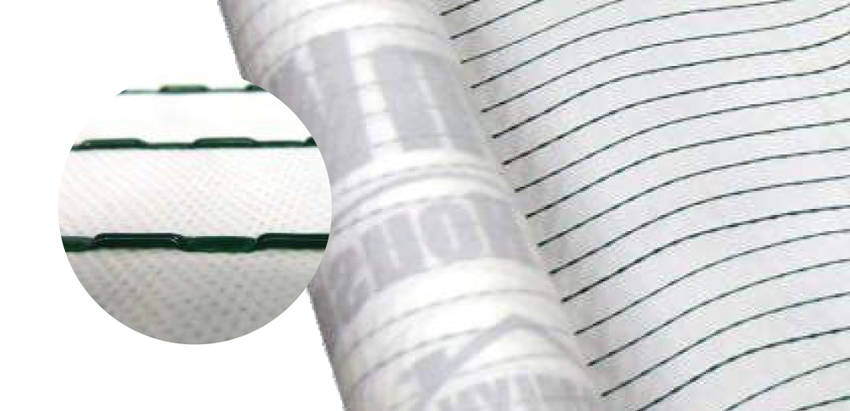
Filaments should be 1.5 millimeters high to provide a sufficient capillary gap.
Another factor to consider in drainage wrap is the distance the wrap holds off the cladding to allow moisture to drain away. If the distance is too little, the effectiveness of the system will suffer. As an example, a 1.5-millimeter standoff from the cladding would be considered a highly effective distance that will allow the product work. And of course, the material that makes up the standoff must be noncompressible. If it is soft and pliable and flattens over time, the effectiveness of the system will likewise suffer, and the moisture will not drain away in a timely manner. A gap design of sufficient distance and durability provides a true drainage space or capillary break between the sheathing and cladding material.
Installation of Drainable Housewrap
Choosing the right housewrap requires an understanding of the product’s key attributes, including water resistance, durability, vapor permeability, and drainage. Installation is also critical.
The biggest key with any wrap or flashing is to always install in shingle fashion, so installation will begin at the base of the wall and openings and move vertically. This means that that the installer moves from the bottom of the wall and works up. Proper shingling is required to shed water and prevent water from entering the wall system.
For products with adhered filaments, commonly available scissors are preferable to a utility knife to cut the wrap. That’s because the use of a utility knife will break the bond of the filaments (spacers) to the wrap. The wrap is unrolled with the spacers facing to the exterior and fastened to the sheathing with cap fasteners. Fasteners should provide a minimum ½-inch penetration into the nail base and be spaced approximately 3 feet apart. All horizontal seams should overlap 4 inches, and vertical seams should overlap by at least 6 inches. Housewrap should extend a minimum of 2 inches over the sill plate.
Rainscreen Standards
Over the decades, building codes have evolved to ensure that moisture does not accumulate inside building envelopes. For instance, the International Residential Code (IRC) states: Exterior walls shall provide the building with a weather-resistant exterior wall envelope. The exterior wall envelope shall include flashing as described in Section R703.8. The exterior wall envelope shall be designed and constructed in such a manner that prevents the accumulation of water within the wall assembly by providing a water- resistive barrier behind the exterior veneer as required by Section R703.2 and a means of draining water that enters the assembly to the exterior (Wall Covering, Section R703: Exterior Covering and R703.1: General).
Proper specification and installation of flashings are critical factors for dry and durable building envelopes. Regarding flashings, the code says: Approved corrosion-resistive flashing shall be applied shingle fashion in such a manner to prevent entry of water into the wall cavity or penetration of water to the building structural framing components. The flashing shall extend to the surface of the exterior wall finish (Section R703.8: Flashings).
The section on exterior walls reiterates the need for moisture control and references the International Energy Conservation Code (IECC). The IRC states: Exterior walls shall provide the building with a weather-resistant exterior wall envelope. The exterior wall envelope shall include flashing, as described in Section 1405.3. The exterior wall envelope shall be designed and constructed in such a manner as to prevent the accumulation of water within the wall assembly by providing a water-resistant barrier behind the exterior veneer, as described in Section 1404.2, and a means for draining water that enters the assembly to the exterior. Protection against condensation in the exterior wall assembly shall be provided in accordance with the International Energy Conservation Code (Exterior Walls, Section 1403.2, IBC).
How Drainage Wraps and Rainscreens Open Up Possibilities for Innovative Trims
The growing use of drainable housewraps at first glance might not seem intricately related to exterior trims and reveals—but it is. In the past, architects and designers who are knowledgeable about water intrusion in the building envelope took care to minimize perforations into the exterior cladding to eliminate the potential for water or vapor getting past the cladding and then having a hard time drying out. But with a drainage plane in place, along with a method to hold the back of the cladding off the drainage plane, moisture getting past the cladding has less potential for problems. The water gets in, and the water gets out.
Trims and reveals are favorite design materials of many architects. They add interest to exteriors and provide visual relief to otherwise boring or humdrum expanses of exterior wall. Reveals and trims lend an instant contemporary aesthetic and sharpness to any exterior.
In the multifamily housing industry, where return on investment (ROI) is highly tracked and operational costs are highly considered, a building designed and constructed with superior moisture-control measures will have a better ROI than one more susceptible to moisture damage. At the same time, in a competitive market, a multifamily building with a sharp, modern aesthetic will fare better in the pricing scheme than will a building with a less remarkable appearance.
Giving Traditional Cladding a New Refined Aesthetic
Because of the sophistication and efficacy of rainscreens and drainable housewraps, architects, designers, and specifiers can confidently explore the use of metal trims and reveals without concern about damaging water intrusion into the building envelope. In fact, reveals and metal trim give new refinement and detail to such common and traditional siding materials as wood, lap sidings, composites, and others.
Materials Used for Trims and Reveals
Over the years, several materials have been used for architectural trims and reveals. Among those are polyvinyl chloride (PVC), galvanized steel, and extruded aluminum.
PVC
Originally, reveal trim profiles were developed and manufactured by an innovative building materials company with PVC to use with fiber cement siding and soffits. But through learned experiences and public demand, the industry began converting its profiles into more durable materials. The reason: dark-colored PVC will not work with dark colors. And as architects, contractors, and developers began using dark colors for many of their projects, it was apparent the 100 percent vinyl trim was susceptible to swelling and buckling when exposed to direct sunlight. That problem would become more pronounced with global climate change and extreme record-breaking weather patterns, including extreme heat.
Galvanized Steel
The use of bare galvanized steel in direct contact with most claddings will increase chances of a chemical reaction, causing wear and breakdown on both products. Also, steel is typically bent for the application, so it has limitations in shapes. That process is not as controlled as an extruded product. And when the steel is on the thinner side, that can lead to waviness in the product.
Extruded Aluminum
Aluminum extrusion is the process of shaping the aluminum by forcing it to flow through a shaped opening in a die. The extruded aluminum emerges as an elongated piece with the same profile as the die opening.

Extruded aluminum reveal profiles add durable and stylish accents to multifamily buildings.
AA 6063 is an aluminum alloy, with magnesium and silicon as the alloying elements. The Aluminum Association maintains the standard controlling its composition. It has generally good mechanical properties and is heat treatable and weldable. 6063 is the most common alloy used for aluminum extrusion.
Extruded aluminum trim is typically fabricated from custom die-extruded heavy-duty 6063 T-5 aluminum alloy with a coating that protects against harsh weather conditions and allows for paint adhesion.
The trim and reveal made from extruded aluminum are typically designed to match color and dimensions of the country’s major cementitious siding manufacturers and a number of other materials. These pieces replace the time-consuming cutting and ripping of fiber cement panels or boards for trim use.
Extruded aluminum poses no health or physical hazard. Note that aluminum trim products are defined as “articles” by the Occupational Safety and Health Administration (OSHA) and are therefore exempt from the requirement of publishing material safety data sheets.
Colors and Finishes
Depending on the manufacturer, the extruded aluminum trim and reveal accents needed to satisfy a certain aesthetic may be available in a choice of primed, clear anodized, specialty anodized, or color matched to satisfy whatever the project requires.
A clear anodized finish is an electrochemical conversion process that deposits an oxide film on the aluminum trim. A natural oxidation process occurs on bare aluminum; however, producing the oxidation process artificially creates a thicker, harder, and more durable “oxide film.” Clear anodized exterior siding is an extremely durable finish and is resistant to most forms of corrosion.
Specialty color anodized trims option finishes may also be available, such as gold anodized, black anodized, and bronze anodized exterior siding option finishes. It is important for the designer to note that anodized finishes can vary from one piece of trim to another. This is one of the characteristics to the anodizing process and must be considered before any orders are placed. Typically, the color of the anodizing will fall within a certain range, which usually can be determined in consultation with the manufacturer.
For simplicity, a stock color may be specified. There has been an explosion of colors available from manufacturers, and intensive color research determines the most trendy colors for multifamily projects. Depending on the manufacturer, there may be a wide choice of stock colors, such as these:
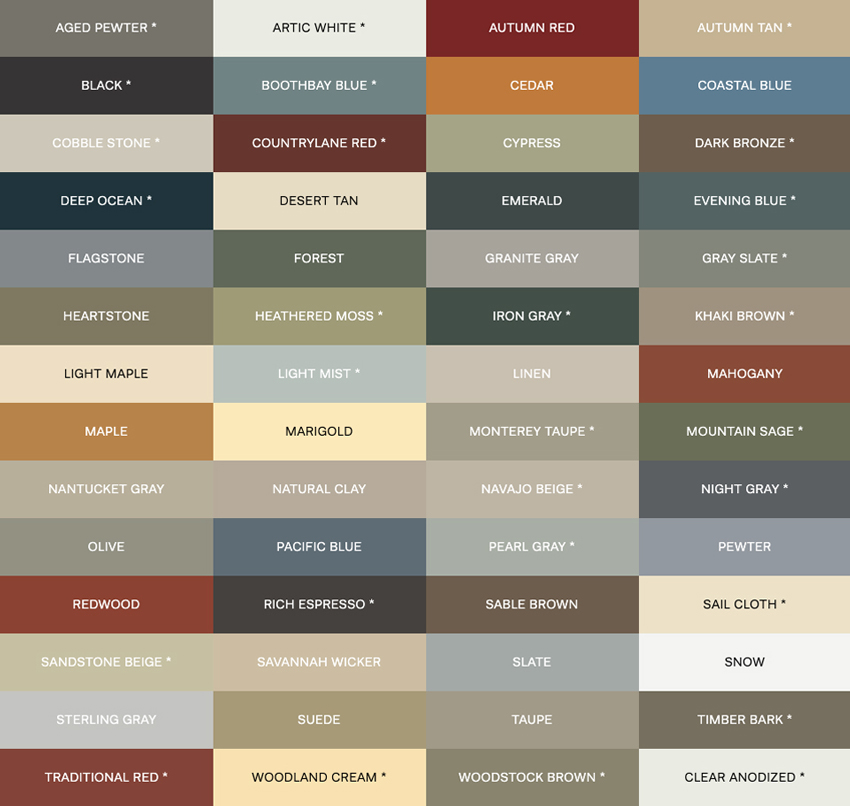
Shown are examples of stock colors that may be available depending on manufacturer.
How Reveals and Trims Add Interest to Multifamily Exteriors
The aesthetic required for today’s successful multifamily development is likely clean, modern, and sharply defined. The range of extruded aluminum reveals that contribute to such a look fall into several categories: vertical reveals, horizontal reveals, outside corners, inside corners, and transition reveals. Let’s consider each individually and review examples.
Vertical Reveal Profiles
Vertical reveals are designed to create a uniform, aesthetically consistent reveal between panel or lap siding. The design of the profile can create a broad vertical accent between siding panels, subtle variation, or even profiles that project beyond the plane of the wall. Here are some types.
This profile gives a consistent reveal while providing flanges to cover the cut edges of the panel. Depending on the manufacturer, a two-piece version of this type of profile may be available, which eases installation because the base and panels are laid out with the cap being attached afterward.
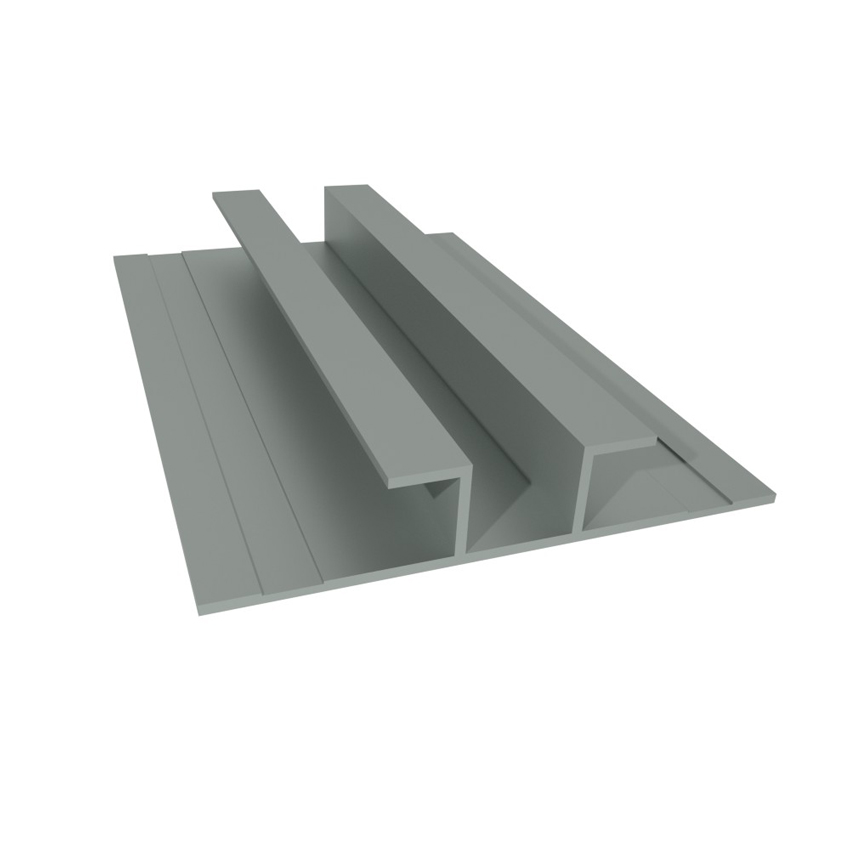
Shown is a one-piece vertical reveal type profile.
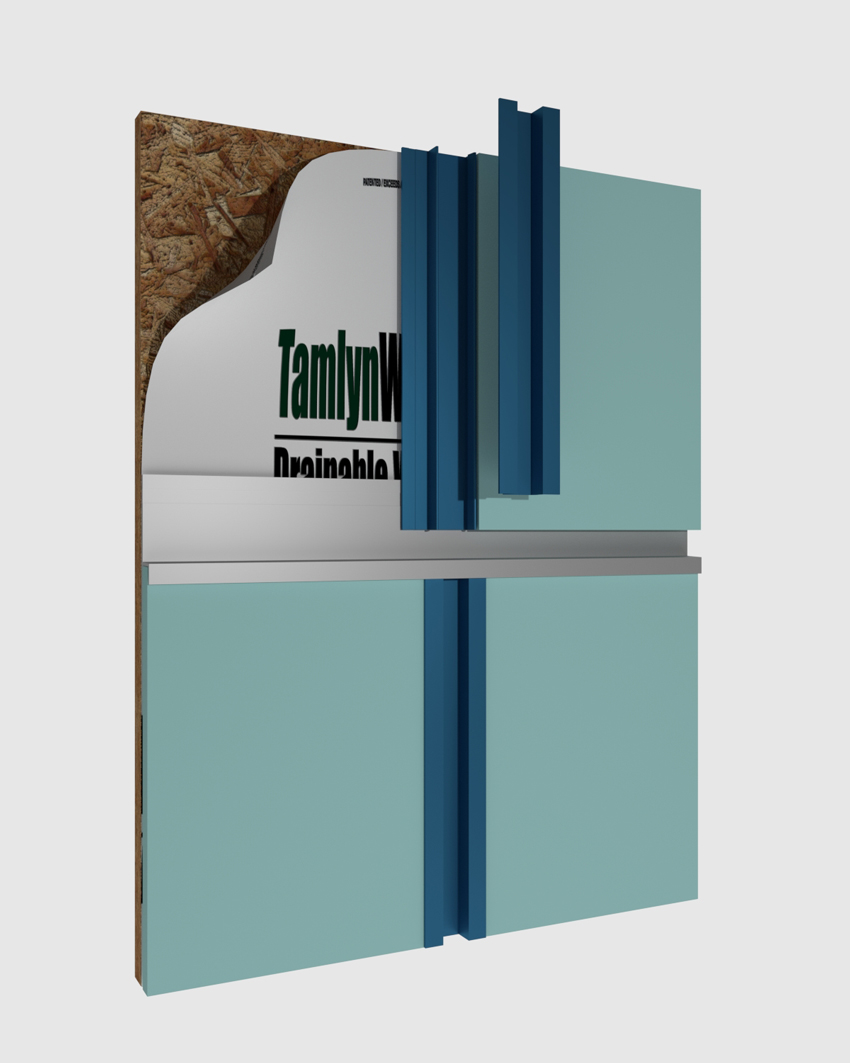
Shown is a two-piece vertical reveal type profile.
This type of reveal profile was specified for CityScape at Belmar, a four-story, 130-unit senior housing complex in Lakewood, Colorado. It was designed by Denver-based Studio Conpletiva. The building configuration is a south-facing C-shaped courtyard with views of a wetland detention pond. According to the architect’s website: “The exterior massing is broken down with a rainscreen panel system, cement fiber panels siding, and a metal panel system with shadow boxes to create interest and scale on the facade.”4 The reveal system pieces were color matched for each section of the vibrant exterior.
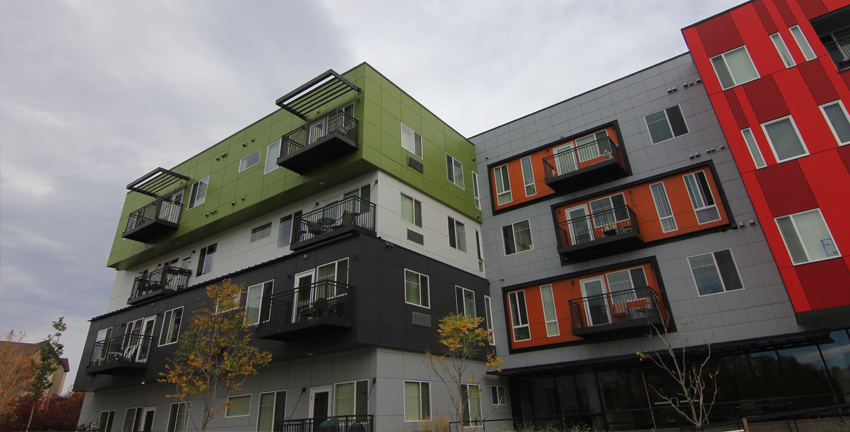
CityScape at Belmar senior housing complex features color-matched aluminum trim profiles.
This type of reveal profile was also specified for the Ryman Lofts, a 60-unit LEED Silver affordable multifamily project in Nashville, Tennessee. It was developed exclusively for artists in downtown Nashville’s Rolling Mill Hill neighborhood and designed by Smith Gee Studio.5 In this case, the reveal system of extruded aluminum was given a clear anodized finish to provide a subtle accent to the colored panels. The project won many awards, including the AIA Middle TN People’s Choice Award.

Ryman Lofts is a 60-unit LEED Silver affordable multifamily project in Nashville.
Vertical Bead Reveal Type of Profile
The vertical bead reveal serves as an aesthetic joint between panels. This is considered by some as a more appealing and secure solution to the “open-wall” vertical joint look popular in many areas.
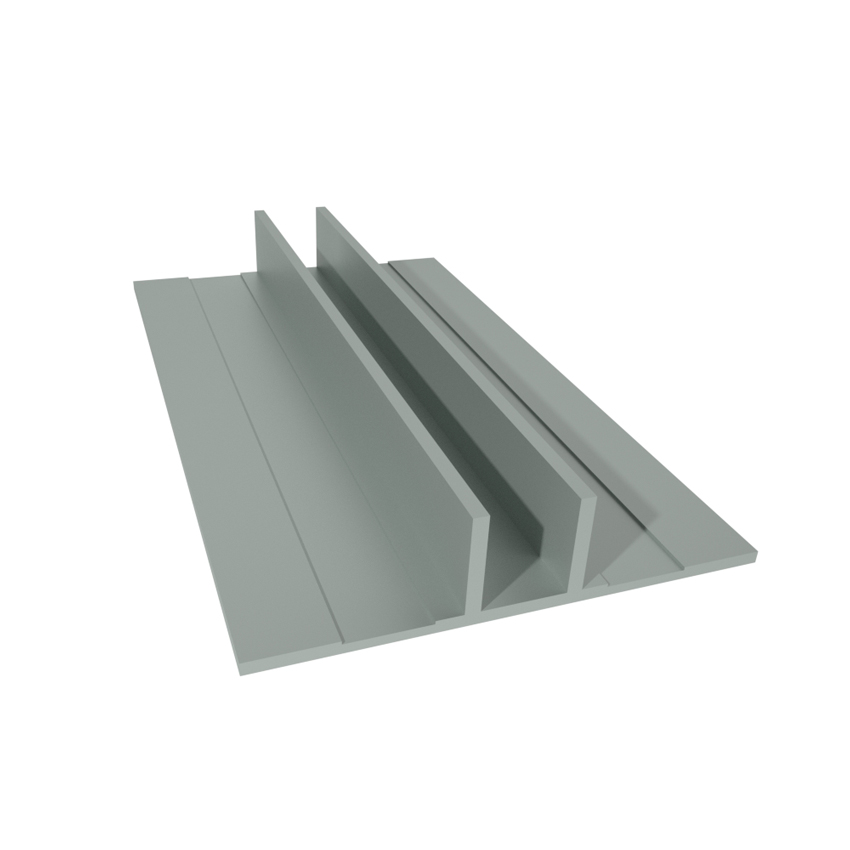
Shown is a bead type of reveal.
This type of profile was specified for the Pierce Apartments, a mixed-use residential project in San Jose, California. It was designed by San Francisco-based Steinberg Hart, which has offices on the West Coast and Shanghai. The bead reveal type of profile was finished in a contrasting black.

A bead type of reveal was used for the Pierce Apartments in San Jose, California.
Horizontal Z Reveal Type of Profile
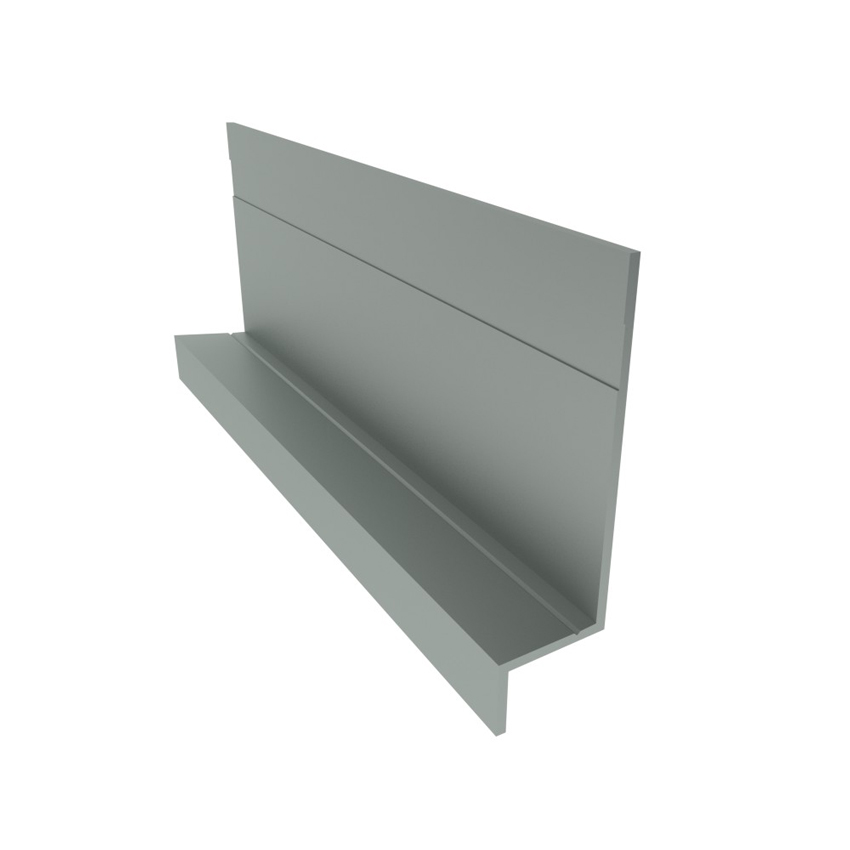
Shown is a Z reveal type of profile.
This type of reveal profile was specified for Apex 55 Apartments, a 231-unit multifamily housing project in Boulder, Colorado. The solid panels juxtapose nicely with horizontal wood siding. The extruded horizontal Z reveals and vertical reveals add interest to the solid panels as well as a clean and consistent transition between the panels. Brick accents add further interest.
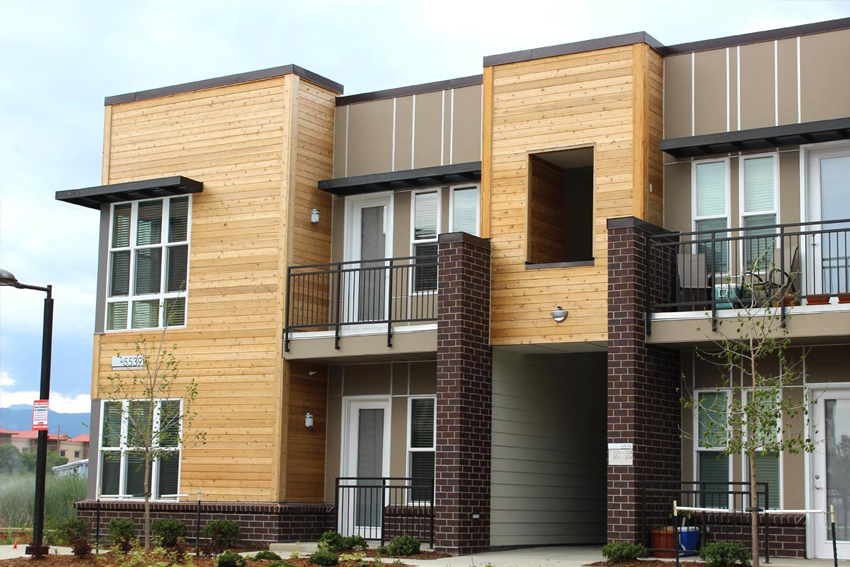
Extruded aluminum reveals were specified for the 55 Apex Apartments in Boulder, Colorado.
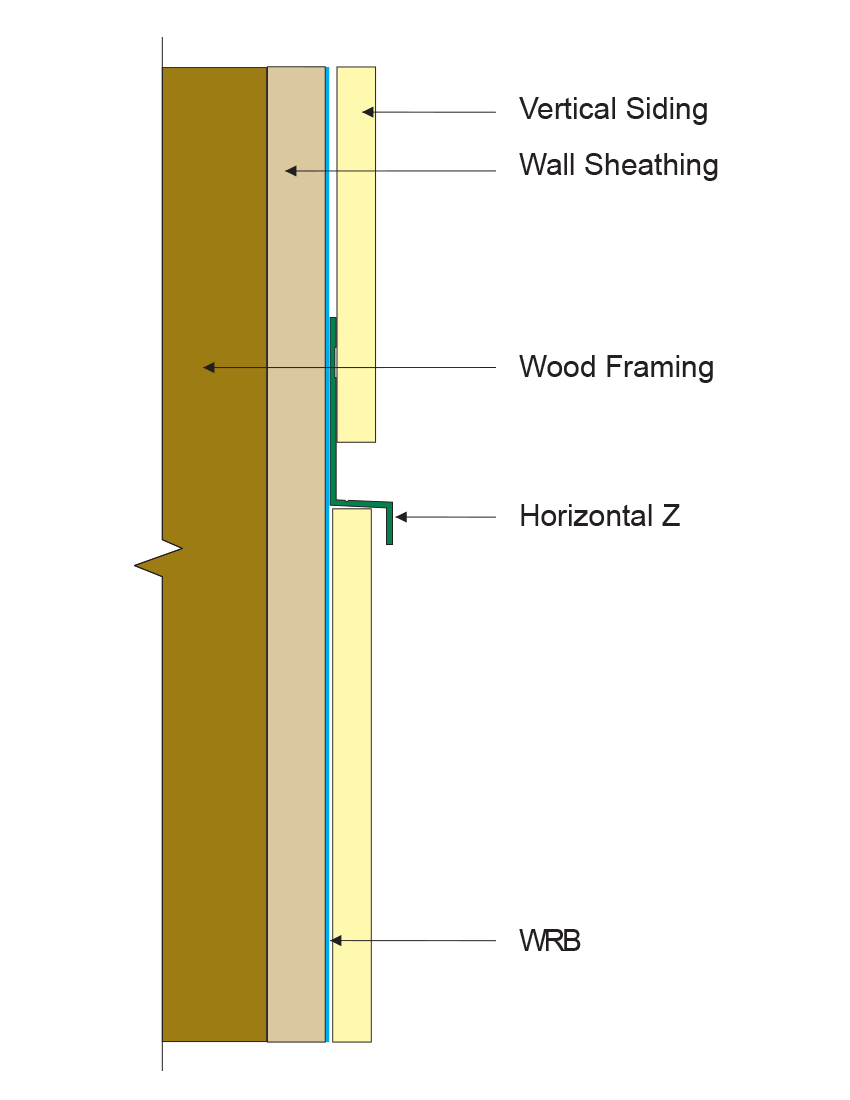
This is how the reveal integrates into the wall assembly, which includes a WRB/drainage plane.
Horizontal Board Reveal Profile Type
This type of profile creates a broad horizontal accent within the plane of the wall without protruding beyond that plane. It creates a sleek and modern aesthetic with a visually impactful extruded aluminum reveal. The retention leg on the back prevents flexing with installation. This type of reveal was specified for the 3900 Aldine project featured in the accompanying case study.
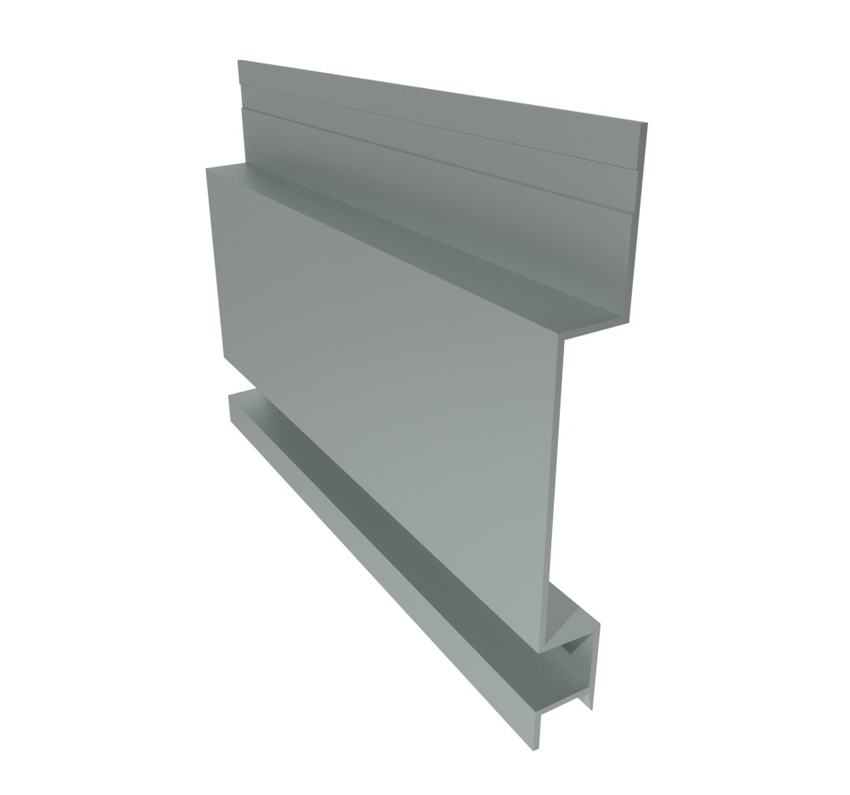
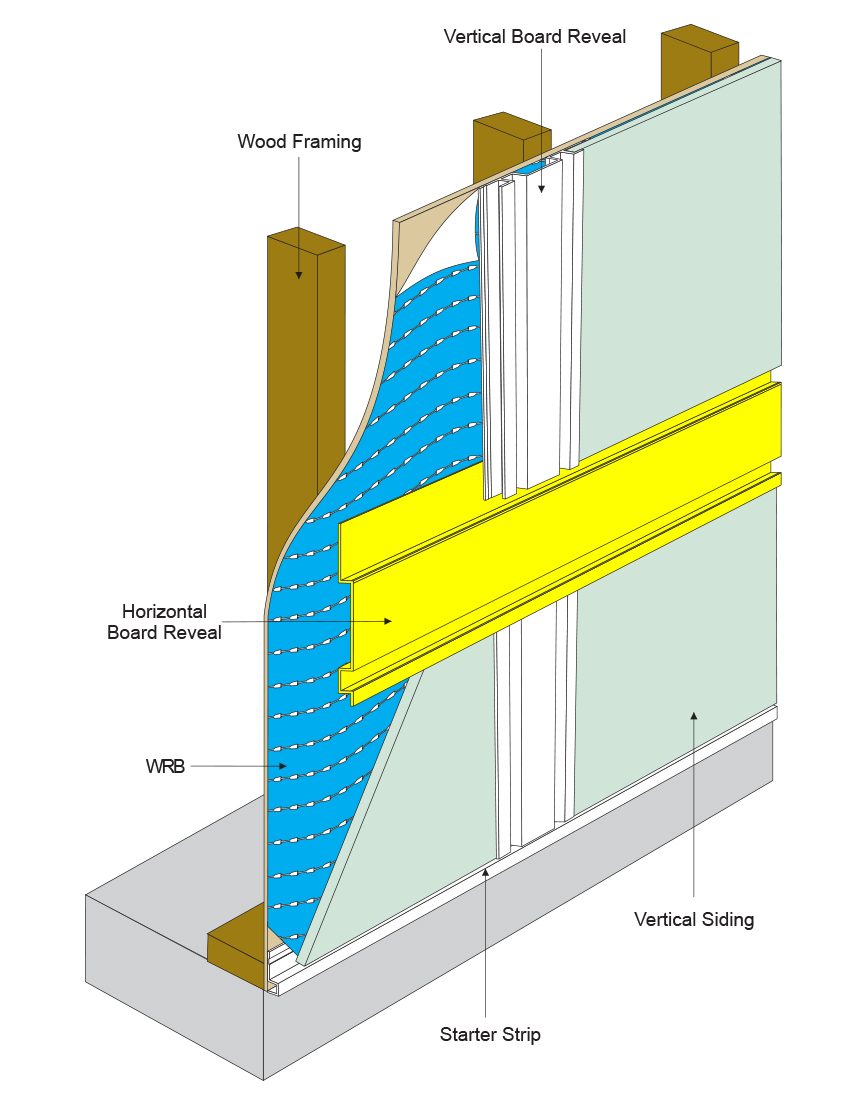
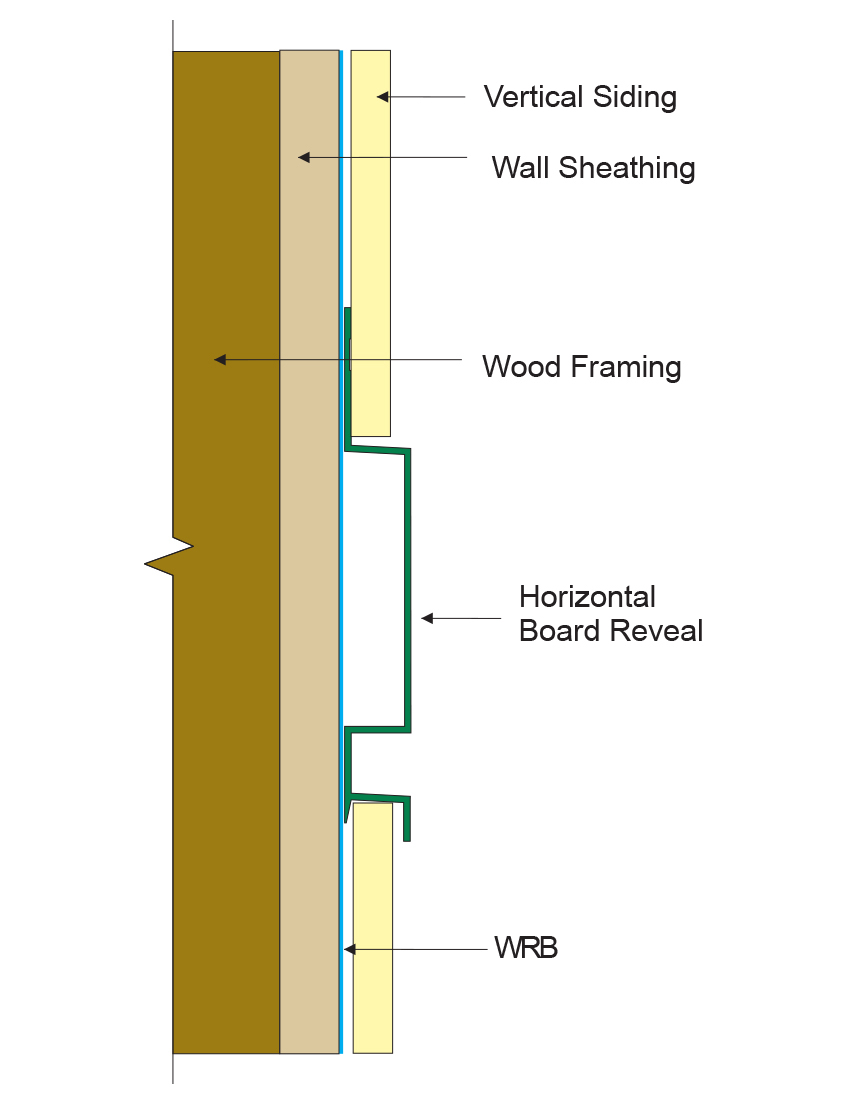
Shown is a horizontal bead type of reveal. This is how this type of reveal profile integrates into a wall assembly.
Outside Corner Reveal Profile Types
This type of extruded aluminum trim creates a clean and simple modern look for durable outside corners that will not or degrade. This type of product with a black anodized finish was specified for the 17 Walnut modern lofts project in Boulder, Colorado. According to the architects who designed the project, Studio Architecture, the City of Boulder uses this project as an example of the type of buildings it wants developed in the city.6

A low-profile extruded aluminum corner piece with black anodized finish was specified for the 17 Walnut lofts in Boulder, Colorado.
Another profile that adds modern interest to an exterior is a reveal outside corner, which is a corner that steps back. Depending on the manufacturer, it may be available in different sizes to work with different panel and lap products. A corner trim with this profile was specified for the Cortona at Forest Park project in St. Louis. It was designed by Humphreys & Partners Architects, which has offices all over the world and specializes in multifamily projects. The colorful project has 278 units in five stories. The project won many awards, including a 2015 Gold Nugget Award of Merit in the category of Best Multifamily Housing Community, 2015 City of St. Louis Property of the Year, and was named one of the top five new residential developments of 2014 in St. Louis by St. Louis Magazine.7

Cortona at Forest Park in St. Louis is a colorful multifamily housing project that features distinctive corner trim made of extruded aluminum. A clear anodized finish provides an out-of-the-ordinary aesthetic.
Transition Profile Types
Creating a smooth transition between different types of exterior cladding is a challenge many designers face. While a single cladding type eliminates this issue, that kind of design decision can make for a building that lacks interest. These types of profiles provide a smooth transition from different cladding types, such as from vertical siding panels to lap siding. A low-profile outside corner design may authentically duplicate the look of a wood corner piece without the maintenance headaches. An inside corner option may eliminate a wooden inside corner piece that could split/rot over time.
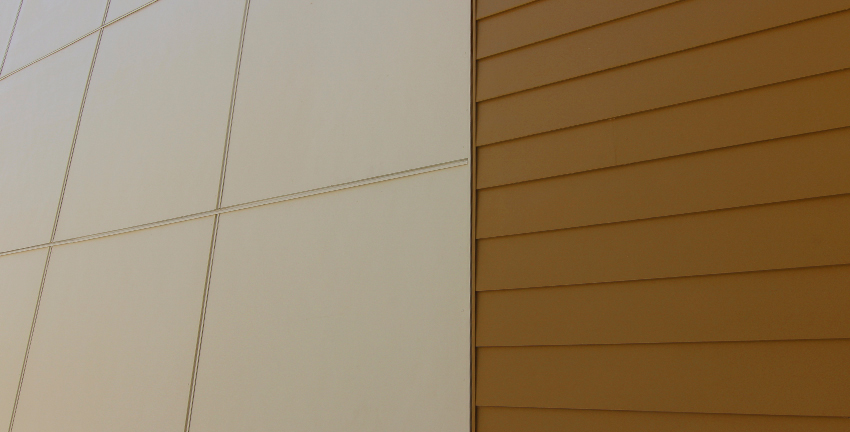
This trim provides a transition between different types of cladding.
One project whose designer specified inside corner trim made of extruded aluminum is the Goldsmith Village Townhomes in Denver. The 35 units were built in 1979 and renovated using Low-Income Housing Tax Credits.8 The redevelopment project architect was Gensler, and the owner is the Denver Housing Authority. New exterior siding was part of the overall upgrade, and the blend of panels and lap siding gives the project architectural interest. The architects specified the inside corner trim in a clear anodized finish to create a transition between the differing materials. The new exterior siding, along with other energy-efficient features such as new windows and doors and high-efficiency water heaters, helped the project earn an Enterprise Green Built Communities certification.

Trim pieces made of extruded aluminum with a clear anodized finish were specified for the inside corner transitions at Goldsmith Village Townhomes in Denver.
Installation of Extruded Aluminum Architectural Reveals
For proper installation, always check with the manufacturer’s instructions. Typically, though, stainless steel fasteners are recommended for extruded aluminum pieces. Trim profiles may be secured in place with a few stainless steel nails until fastened through panels and into sheathing during panel or plank fastening per siding manufacturer’s instructions. Also very commonly used and accepted are galvanized fasteners.
It is recommended by most manufacturers that inset fiber cement panels be fastened to the wall with stainless steel Torx head screws or hot-dipped galvanized siding nails.
As per manufacturer’s instructions, sealant is likely recommended between butt joints where two trims come together. Further protection may be created by use of a piece of flashing behind the butt joint or with a metal flasher behind the joint.
LEED and Green Building
Depending on the manufacturer, extruded aluminum trim may be made from up to 75–100 percent post-industrial and post-consumer scrap. It’s good to remember that extruded aluminum is extremely durable and should outlast caulk by generations. The installation process itself is inherently sustainable, as it saves some cutting and ripping of siding materials.
These factors may help the building achieve credits from LEED or other green building rating systems. For LEED certification, aluminum trims and reveals can earn or contribute to credits in the Materials and Resources 4.1 and 4.2 categories. These credits require a minimum percentage of the value of the building materials to be recycled.
Working with Manufacturers
In an ideal world, the manufacturer of water management systems and/or architecturally interesting trim and reveal pieces will have the staff and resources available to help design the building envelope for ultimate form and function. When a manufacturer has thousands of design and color options, this allows architects and users to dramatically improve their building aesthetics and create modern architectural lines preferred by millennials and others in today’s market. But without knowledgeable assistance, specifying the best products or combination of products can be a daunting task.
A manufacturer may have its own team of architects in-house to aid and assist the process of selecting and assuring the correct profile for the specific application or desired aesthetic effect. Depending on the size and flexibility of the manufacturer, it may also have the ability and materials to provide appropriate non-extruded fabrication from sheet stock of almost any shape or profile that may be needed on a project.
For best results, an architect should rely heavily on the knowledge and expertise of the manufacturer chosen for the project.
Conclusion
There is growing recognition among building scientists and codes that walls need to drain, and, going forward, housewraps will increasingly be judged by how effectively they provide positive drainage of water from the wall. Specifying a drainable housewrap provides an extra insurance that moisture that finds its way behind the cladding can easily find its way out.
At the same time, sophisticated products and processes that create a wall assembly increasingly capable of drying out and preventing moisture damage to the envelope and building open the door to new types of trim and reveals that can be considered for multifamily housing projects. New profiles of extruded aluminum trim products have made it possible to aesthetically trim almost any type of siding panel or plank product with a wide range of depth options. And they may be available in choices of primed, clear anodized, specialty anodized, or color matched to satisfy whatever the project requires.
With a superior drainage plane and aesthetically dynamic trim and reveal products, multifamily housing projects can achieve the ultimate dream of architects, designers, and specifiers: a perfect blend of form and function.
Kathy Price-Robinson writes about building and design. Her remodeling series “Pardon Our Dust” ran 12 years in the Los Angeles Times. She specializes in writing about buildings that are durable and resilient to climate disruptions, as well as products and designs that provide shade in hot climates. www.kathyprice.com
End Notes
1“Growth in Urban Population Outpaces Rest of Nation, Census Bureau Reports.” Newsroom. United States Census Bureau. 28 March 2012. Web. 7 April 2019.
2Dure, Beau. “Millennials Continue Urbanization of America, Leaving Small Towns.” National Public Radio. 21 October 2014. Web. 7 April 2019.
3Pack, Andrew A. “Increasing Density: A Small-Town Approach to New Urbanism.” Bridges. Fall 2013. Web. 7 April 2019.
4“CityScape at Belmar.” Studio Completiva. Web. 7 April 2019.
5“Ryman Lofts.” Smith Gee Studio. Web. 7 April 2019.
6“17 Walnut.” Studio Architecture. Web. 7 April 2019.
7“Cortona at Forest Park.” Humphreys & Partners Architects. Web. 7 April 2019.
8“Syracuse Plaza and Goldsmith Village.” Milender White. Web. 7 April 2019.


































